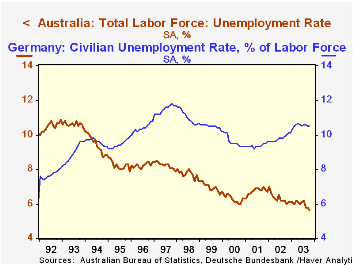 Global| Nov 06 2003
Global| Nov 06 2003Unemployment Picture Improves in Australia, Germany
Summary
Ahead of tomorrow's big labor market report in the US, Australia and Germany both reported generally favorable moves in unemployment in October. In Australia, in particular, the rate decrease 0.2% to 5.6% from 5.8% in August and [...]

Ahead of tomorrow's big labor market report in the US, Australia and Germany both reported generally favorable moves in unemployment in October. In Australia, in particular, the rate decrease 0.2% to 5.6% from 5.8% in August and September. 5.6% is the second lowest in the nearly 24-year history of the data. It is also the lowest since the end of 1989, when it was also 5.6%; the record low was 5.4% in mid-1981.
This performance accompanied an increase in employment of 69,100 in October and a total rise of 164,500 over the last three months. Labor force participation is up 0.4% in the last three months as well, to 63.8% from 63.4% in July, underscoring that the reduced unemployment is in fact due to more job opportunities, not people's withdrawal from the labor force. Quite the contrary.
Unemployment in Germany held steady at 10.5%, including a flat 8.4% in Western Germany and a decrease from 18.6% to 18.5% in Eastern Germany. The improvement here is slight, but has been sustained over several months. In Western Germany, the rate has been unchanged since June, while in Eastern Germany, it has fallen 0.4% since that same month. Employment data are reported later in Germany and have just been released for August, when jobs were still decreasing, albeit modestly. (See table below.) Thus, some of the unemployment "improvement" in that country has resulted from a smaller labor force, which is not much sign of economic strength. However, recent gains in business confidence and in the Purchasing Managers surveys suggest that employers are beginning to regard employment prospects more positively or at least less negatively. The employment component of the PMI for the services sector, at 43.8 in October, remains below the expansion-contraction 50% breakpoint, but it is still 3.5 percentage points above its January low. So labor market conditions look to be moving toward recovery in Germany.
| Labor Market Indicators | Oct 2003 | Sept 2003 | Aug 2003 | Year Ago |
2002 | 2001 | 2000 |
|---|---|---|---|---|---|---|---|
| Australia: Unemployment Rate (%) | 5.6 | 5.8 | 5.8 | 6.0 | 6.3 | 6.7 | 6.3 |
| Australia: Employment (Change, thous) | 69 | 15 | 81 | 21* | 23* | 7* | 15* |
| Germany: Unemployment Rate (%) | 10.5 | 10.5 | 10.6 | 10.0 | 9.8 | 9.4 | 9.6 |
| Western Germany (%) | 8.4 | 8.4 | 8.4 | 7.8 | 7.7 | 7.2 | 7.5 |
| Eastern Germany (%) | 18.5 | 18.6 | 18.6 | 17.8 | 17.7 | 17.3 | 17.1 |
| Germany: Employment (Change, thous) | N.A. | N.A. | -29 | -39* | -42* | -6* | 45* |
| Germany: PMI Services Employment (50 = Expansion/Contraction) | 43.8 | 43.7 | 43.2 | 40.3 (Jan '03 low) |
46.5 | 49.7 | 53.8 |
Carol Stone, CBE
AuthorMore in Author Profile »Carol Stone, CBE came to Haver Analytics in 2003 following more than 35 years as a financial market economist at major Wall Street financial institutions, most especially Merrill Lynch and Nomura Securities. She had broad experience in analysis and forecasting of flow-of-funds accounts, the federal budget and Federal Reserve operations. At Nomura Securities, among other duties, she developed various indicator forecasting tools and edited a daily global publication produced in London and New York for readers in Tokyo. At Haver Analytics, Carol was a member of the Research Department, aiding database managers with research and documentation efforts, as well as posting commentary on select economic reports. In addition, she conducted Ways-of-the-World, a blog on economic issues for an Episcopal-Church-affiliated website, The Geranium Farm. During her career, Carol served as an officer of the Money Marketeers and the Downtown Economists Club. She had a PhD from NYU's Stern School of Business. She lived in Brooklyn, New York, and had a weekend home on Long Island.





